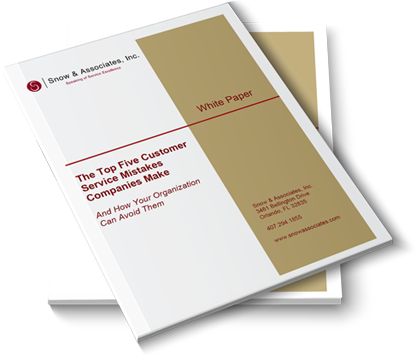
The Top Five Customer Service Mistakes That Companies Make
And How Your Organization Can Avoid Them.
Posted on February 1, 2021 by Dennis Snow
As we get into the meat of 2021 (it’s already February!), would you like a a way to engage (or re-engage) your people in creating loyalty-driving customer experiences? A proven way to accomplish this is to reconnect your employees to the purpose of what they do. Employees who understand the true purpose or bigger picture of their jobs will always perform better than those who see their role as simply completing a series of tasks.
What I’m talking about is creating a purpose statement for your organization (or refining the one you already have). I’m fully aware that when I talk about things like purpose statements, some folks roll their eyes because they see creating things like purpose statements as meaningless, consultant-driven exercises. And it can be a meaningless exercise if the purpose statement is created as just an exercise.
But when created and used strategically, an effective purpose statement can mobilize people to do things they never thought possible. To focus on something beyond themselves. President John F. Kennedy verbalized a powerful, motivating purpose statement when he said in 1961, “I believe that this nation should commit itself to achieving the goal, before this decade is out, of landing a man on the Moon and returning him safely to Earth.” Not a lot of words in that statement – it’s pretty clear what the purpose was. And tens of thousands of workers focused themselves on that purpose, and they succeeded spectacularly.
From a business perspective, I must share the power that the Walt Disney Company’s purpose statement had on me. The statement was simply this: “We create happiness by providing the finest in entertainment for people of all ages, everywhere.” This simple statement provided a context for why I was loading people on rides, answering the same question for the thousandth time, helping guests find a particular attraction, or picking up a stray piece of trash off the ground. I was creating happiness, and that was a pretty special job to have.
An effective purpose statement answers two questions:
Pretty simple, huh? I think any organization can get their arms around these two straightforward questions. The problem comes when an organization over complicates the process, creating a statement two pages long that no one in the organization can even recite. The secret is to keep it simple.
Here are a few examples of effective purpose statements from my experience:
Walt Disney World
As I mentioned earlier, their purpose statement is, “We create happiness by providing the finest in entertainment for people of all ages everywhere.”
What does Disney create? Happiness. How do they create it? By providing the finest in entertainment for people of all ages, everywhere.
First Citizens Bank
“We build life-enhancing relationships by helping our customers identify and achieve their financial goals.”
What’s does First Citizens Bank create? Life enhancing relationships. How do they create it? By helping customers identify and achieve their financial goals.
Cool Cuts 4 Kids (hair salon for kids)
“We create excitement by engaging our customers in a fun, friendly, family experience.”
What does Cool Cuts 4 Kids create? Excitement. How do they create it? By engaging customers in a fun, friendly, family experience.
Again, pretty simple. But powerful when used as a tool to align the performance of your team. These statements are easy to explain, train, and coach. They’re easy to keep top of mind. I’m not saying that such statements are magic in themselves; they’re not. They must become embedded in the organization’s culture. They must become second nature. But when they do become second nature, they come pretty close to being magic.
An effective purpose statement focuses your team on what you are really selling beyond the physical product or service. It focuses your team on the WHY behind that product or service. Remember the old sales expression: The customer doesn’t need a ½ inch drill bit, the customer needs a ½ inch hole. Focusing on the why takes things to a whole new level.
Lots of ways exist to create a purpose statement for your organization. You might decide to do it yourself. You might decide to put together a small team to create it. Or, if appropriate, you might decide to engage everyone in the organization in creating it. Just don’t let the statement evolve into “committee-speak.” Keep it simple and just answer as concisely as possible, “What do we create, and how do we create it?”
I know that you might not be responsible for the entire organization. You can do this at the department level as well. What does your department create? How do you create it? You can do this regardless of your sphere of influence. You could even do it just for yourself if you’re not in a leadership position. That’s not a bad idea if you want to create real value for your organization by creating real value for customers.
As I mentioned earlier, a purpose statement isn’t magic. It must be communicated relentlessly, built into new-hire onboarding and ongoing training. It must be coached and celebrated at every opportunity. But when done with a clear purpose and embedded in the culture, an effective purpose statement can be a game changer.
So, here’s something to think about: What does your organization create, and how do you create it?